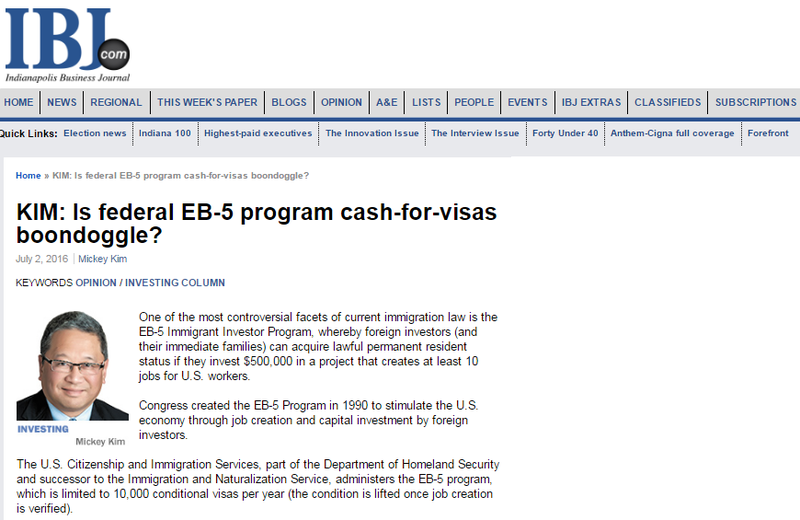KIM: Is federal EB-5 program cash-for-visas boondoggle?
One of the most controversial facets of current immigration law is the EB-5 Immigrant Investor Program, whereby foreign investors (and their immediate families) can acquire lawful permanent resident status if they invest $500,000 in a project that creates at least 10 jobs for U.S. workers.
Congress created the EB-5 Program in 1990 to stimulate the U.S. economy through job creation and capital investment by foreign investors.
The U.S. Citizenship and Immigration Services, part of the Department of Homeland Security and successor to the Immigration and Naturalization Service, administers the EB-5 program, which is limited to 10,000 conditional visas per year (the condition is lifted once job creation is verified).
In 1992, Congress created the Regional Center Program, which allows investments in projects associated with regional centers approved by Citizenship and Immigration Services (currently 838), rather than in specific projects. Regional Centers serve as third-party entities that facilitate the EB-5 process for foreign investors—identifying projects, combining foreign and domestic investments, and managing projects.
The original aim of the EB-5 program was boosting disadvantaged areas by spurring projects that wouldn’t otherwise happen. The stated minimum investment is $1 million, but the threshold is lowered to $500,000 for projects in a “targeted employment area”—i.e. a rural area or an area experiencing unemployment of at least 150 percent of the national average.
According to a report by the Bipartisan Policy Center, “EB-5 Program: Successes, Challenges, and Opportunities for States and Localities,” 97 percent of conditional visas issued in fiscal 2014 were granted through the Regional Center Program and 98 percent were granted to foreigners investing in TEAs.
The EB-5 program started in 1990, but saw little activity until the Great Recession cut-off funding for commercial development. From 806 conditional visas issued as recently as 2007, the 10,000 annual maximum was reached before the end of 2014.
Since developers know foreign investors’ principal motivation under EB-5 is migration, not return on investment, they view EB-5 as a source of extremely cheap financing.
The key for a developer is having your project located in a TEA. Here’s where it gets interesting and controversial. Developers are able to stitch together multiple contiguous census tracts to create a TEA. Voila, a $1.7 billion luxury condo project’s gilded neighborhood at the border of New York’s Central Park was magically transformed into a TEA by linking the planned tower to public housing projects in East Harlem.
New York University real-estate professors Jeanne Calderon and Gary Friedland are the foremost academic experts on EB-5 and published “A Roadmap to the Use of EB-5 Capital.” The database lists 27 major projects that have sought a total of $5.4 billion in EB-5 financing.
Unlike the original aim of EB-5, all of these projects undoubtedly would have happened anyway. Thus, access to cheap EB-5 financing simply increased the developers’ profits. That’s why critics of EB-5 refer to the creation of artificial TEAs as “gerrymandering” and the program itself as “cash-for-visas.” The “winners” are large coastal cities (like New York, L.A. and Miami) and big-name developers foreigners are familiar with. The “losers” are the rural and distressed areas the program was intended to boost.
http://www.ibj.com/articles/59215-kim-is-federal-eb-5-program-cash-for-visas-boondoggle
Mentions
- U.S. Citizenship and Immigration Services
- Central Park Tower [Nordstrom Tower]
- Jeanne Calderon
- Gary Friedland
States
- New York
Videos





Subscribe for News
Site Digest
Join Professionals on EB5Projects.com →
Securities Disclaimer
This website is for informational purposes only and does not constitute an offer or solicitation to sell shares or securities. Any such offer or solicitation will be made only by means of an investment's confidential Offering Memorandum and in accordance with the terms of all applicable securities and other laws. This website does not constitute or form part of, and should not be construed as, any offer for sale or subscription of, or any invitation to offer to buy or subscribe for, any securities, nor should it or any part of it form the basis of, or be relied on in any connection with, any contract or commitment whatsoever. EB5Projects.com LLC and its affiliates expressly disclaim any and all responsibility for any direct or consequential loss or damage of any kind whatsoever arising directly or indirectly from: (i) reliance on any information contained in the website, (ii) any error, omission or inaccuracy in any such information or (iii) any action resulting therefrom.



